Literature Review: Evaluation of Sleep Measuring Tools & Efficacy
VerifiedAdded on 2023/06/04
|11
|3069
|217
Literature Review
AI Summary
This literature review critically evaluates existing studies on sleep measuring devices used by healthcare professionals, addressing issues arising from long working shifts and shift rotations that lead to sleep disorders. It analyzes the use of actigraphy sensors and compares traditional and advanced sleep measurement methods like polysomnography (PSG) and actigraphy, assessing their accuracy and providing recommendations for potential improvements. The review covers the impact of shift work on nurses, including sleepiness, insomnia, anxiety, and fatigue, and examines the effectiveness of consumer sleep tracking devices. While PSG is considered more accurate, actigraphy offers cost-effectiveness and ease of use. Technological advancements in actigraphy, such as improved sensors and smartphone synchronization, are also discussed. The review concludes by highlighting the need for further improvements in sleep measurement accuracy and the potential of fitness bands for monitoring sleep, noting the limitations of relying solely on secondary data and limited sample sizes.
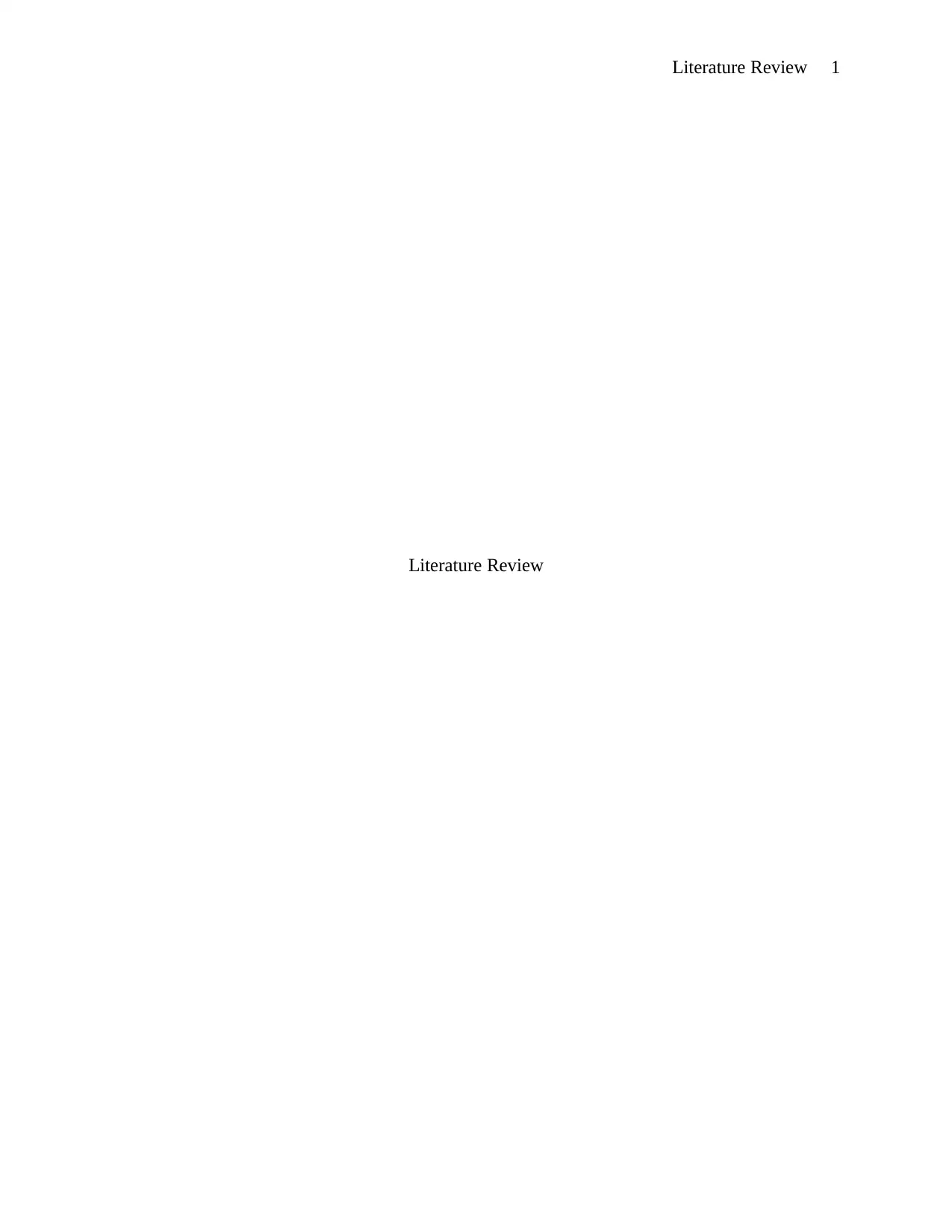
Literature Review 1
Literature Review
Literature Review
Paraphrase This Document
Need a fresh take? Get an instant paraphrase of this document with our AI Paraphraser
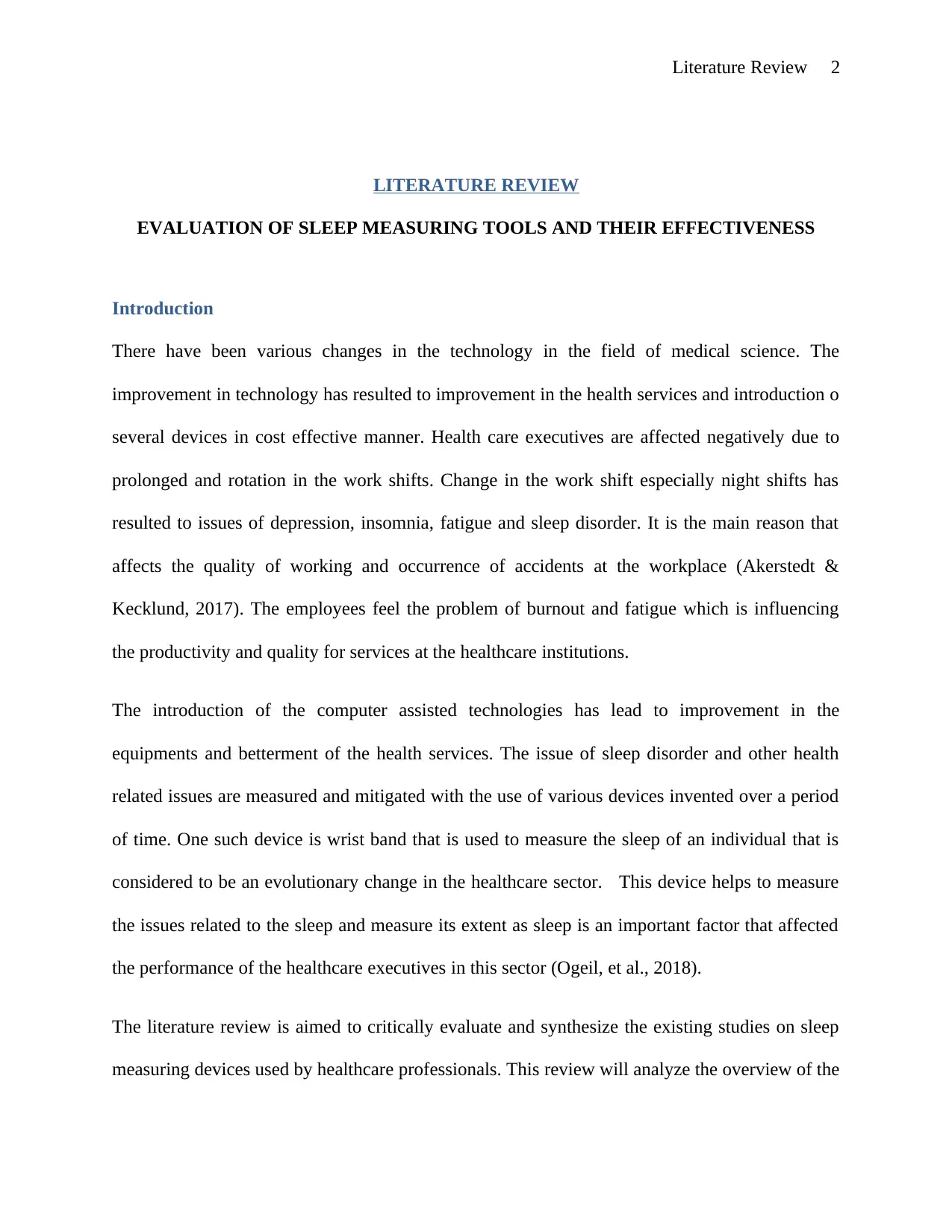
Literature Review 2
LITERATURE REVIEW
EVALUATION OF SLEEP MEASURING TOOLS AND THEIR EFFECTIVENESS
Introduction
There have been various changes in the technology in the field of medical science. The
improvement in technology has resulted to improvement in the health services and introduction o
several devices in cost effective manner. Health care executives are affected negatively due to
prolonged and rotation in the work shifts. Change in the work shift especially night shifts has
resulted to issues of depression, insomnia, fatigue and sleep disorder. It is the main reason that
affects the quality of working and occurrence of accidents at the workplace (Akerstedt &
Kecklund, 2017). The employees feel the problem of burnout and fatigue which is influencing
the productivity and quality for services at the healthcare institutions.
The introduction of the computer assisted technologies has lead to improvement in the
equipments and betterment of the health services. The issue of sleep disorder and other health
related issues are measured and mitigated with the use of various devices invented over a period
of time. One such device is wrist band that is used to measure the sleep of an individual that is
considered to be an evolutionary change in the healthcare sector. This device helps to measure
the issues related to the sleep and measure its extent as sleep is an important factor that affected
the performance of the healthcare executives in this sector (Ogeil, et al., 2018).
The literature review is aimed to critically evaluate and synthesize the existing studies on sleep
measuring devices used by healthcare professionals. This review will analyze the overview of the
LITERATURE REVIEW
EVALUATION OF SLEEP MEASURING TOOLS AND THEIR EFFECTIVENESS
Introduction
There have been various changes in the technology in the field of medical science. The
improvement in technology has resulted to improvement in the health services and introduction o
several devices in cost effective manner. Health care executives are affected negatively due to
prolonged and rotation in the work shifts. Change in the work shift especially night shifts has
resulted to issues of depression, insomnia, fatigue and sleep disorder. It is the main reason that
affects the quality of working and occurrence of accidents at the workplace (Akerstedt &
Kecklund, 2017). The employees feel the problem of burnout and fatigue which is influencing
the productivity and quality for services at the healthcare institutions.
The introduction of the computer assisted technologies has lead to improvement in the
equipments and betterment of the health services. The issue of sleep disorder and other health
related issues are measured and mitigated with the use of various devices invented over a period
of time. One such device is wrist band that is used to measure the sleep of an individual that is
considered to be an evolutionary change in the healthcare sector. This device helps to measure
the issues related to the sleep and measure its extent as sleep is an important factor that affected
the performance of the healthcare executives in this sector (Ogeil, et al., 2018).
The literature review is aimed to critically evaluate and synthesize the existing studies on sleep
measuring devices used by healthcare professionals. This review will analyze the overview of the

Literature Review 3
issues due to long working shifts and rotation in shifts and severity of sleep disorder that has
resulted to the need of its measurement. There is a use of the device named Actigraph also
termed as Actimetry sensor for measurement of the sleep among the individuals (de Zambotti,
Baker & Colrain, 2015). Thereafter, the literature review analyses the traditional and advanced
methods of measuring sleep and access the studies for the justification of the device and its
accuracy to provide recommendations to identify the potential improvements in the area of study.
Overview of the issues related to the working shifts and prolonged working hours in
Nursing
In the words of Ferri, et al., (2016), working in shifts is necessity for continuous care in
healthcare sector. Night shift is considered to be one of the most frequent reasons for affecting
the routine life that results to alteration in the biological functions and sleep. It has resulted to
impact the physical and psychological health of the employee and negatively impact work
performance. The issues arise due to sleep disorder are sleepiness, insomnia, anxiety and fatigue.
There are several other issues such as work pressure, long working hours and operating under
unhealthy conditions that affect the productivity and work efficiency of the healthcare
employees. The issues on health arise due to the resynchronization of the endogenous
physiological system, physiological system, the circadian rhythms physical and psychological
problems due to the issues of fatigue and problems associated with disruption on social life (Lee,
Byun, Keill, Dinkel, & Seo, 2018). In addition to this, it is also identified that the consistency of
the sleep deprivation is highly associated with the rise in the chronic fatigue that affects the
alertness of the person. It is a known fact that the workers working in the healthcare sector are
required to be alert and accurate at the time of shift, as negligence leads to arising severe
consequences to the health of the patients (de Zambotti, et al., 2015).
issues due to long working shifts and rotation in shifts and severity of sleep disorder that has
resulted to the need of its measurement. There is a use of the device named Actigraph also
termed as Actimetry sensor for measurement of the sleep among the individuals (de Zambotti,
Baker & Colrain, 2015). Thereafter, the literature review analyses the traditional and advanced
methods of measuring sleep and access the studies for the justification of the device and its
accuracy to provide recommendations to identify the potential improvements in the area of study.
Overview of the issues related to the working shifts and prolonged working hours in
Nursing
In the words of Ferri, et al., (2016), working in shifts is necessity for continuous care in
healthcare sector. Night shift is considered to be one of the most frequent reasons for affecting
the routine life that results to alteration in the biological functions and sleep. It has resulted to
impact the physical and psychological health of the employee and negatively impact work
performance. The issues arise due to sleep disorder are sleepiness, insomnia, anxiety and fatigue.
There are several other issues such as work pressure, long working hours and operating under
unhealthy conditions that affect the productivity and work efficiency of the healthcare
employees. The issues on health arise due to the resynchronization of the endogenous
physiological system, physiological system, the circadian rhythms physical and psychological
problems due to the issues of fatigue and problems associated with disruption on social life (Lee,
Byun, Keill, Dinkel, & Seo, 2018). In addition to this, it is also identified that the consistency of
the sleep deprivation is highly associated with the rise in the chronic fatigue that affects the
alertness of the person. It is a known fact that the workers working in the healthcare sector are
required to be alert and accurate at the time of shift, as negligence leads to arising severe
consequences to the health of the patients (de Zambotti, et al., 2015).
⊘ This is a preview!⊘
Do you want full access?
Subscribe today to unlock all pages.

Trusted by 1+ million students worldwide
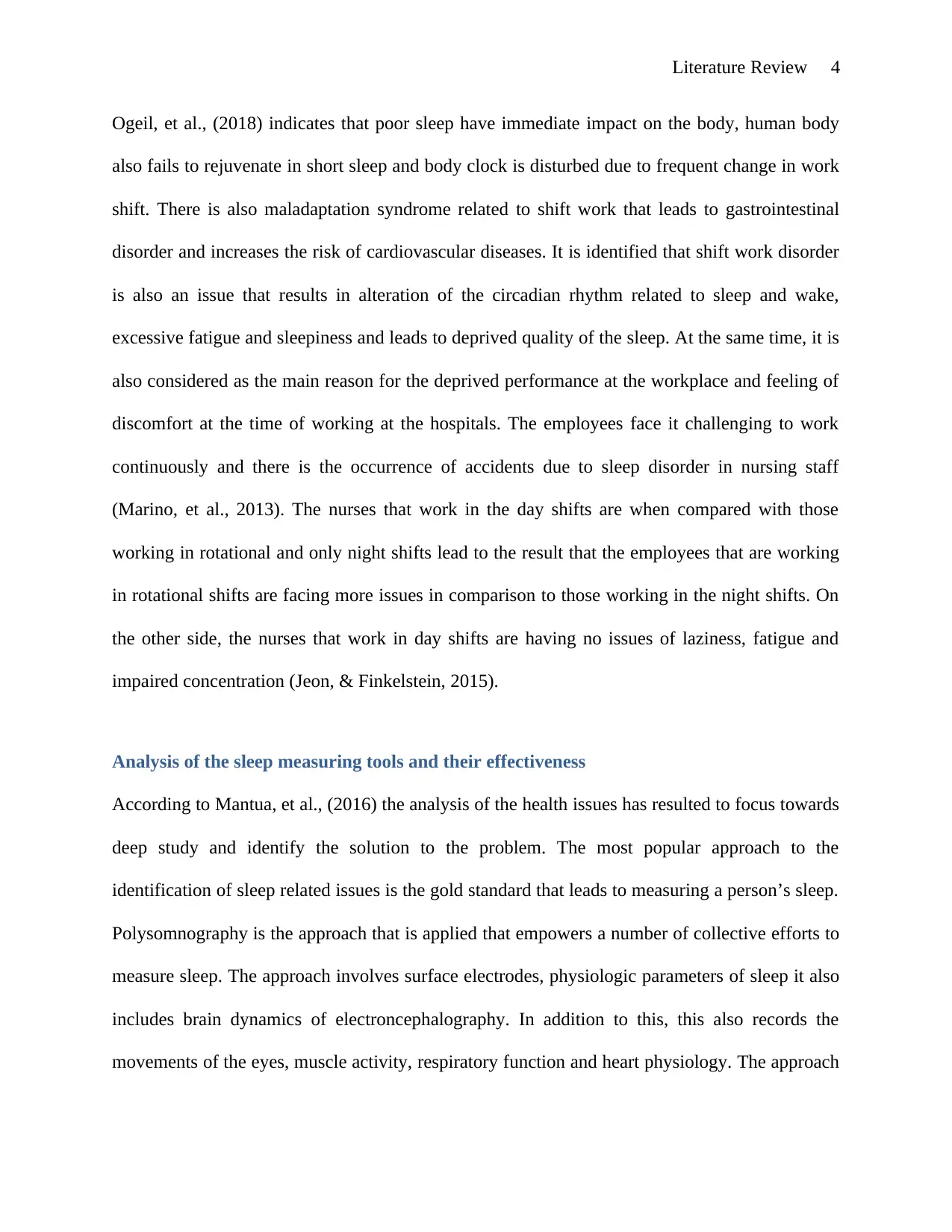
Literature Review 4
Ogeil, et al., (2018) indicates that poor sleep have immediate impact on the body, human body
also fails to rejuvenate in short sleep and body clock is disturbed due to frequent change in work
shift. There is also maladaptation syndrome related to shift work that leads to gastrointestinal
disorder and increases the risk of cardiovascular diseases. It is identified that shift work disorder
is also an issue that results in alteration of the circadian rhythm related to sleep and wake,
excessive fatigue and sleepiness and leads to deprived quality of the sleep. At the same time, it is
also considered as the main reason for the deprived performance at the workplace and feeling of
discomfort at the time of working at the hospitals. The employees face it challenging to work
continuously and there is the occurrence of accidents due to sleep disorder in nursing staff
(Marino, et al., 2013). The nurses that work in the day shifts are when compared with those
working in rotational and only night shifts lead to the result that the employees that are working
in rotational shifts are facing more issues in comparison to those working in the night shifts. On
the other side, the nurses that work in day shifts are having no issues of laziness, fatigue and
impaired concentration (Jeon, & Finkelstein, 2015).
Analysis of the sleep measuring tools and their effectiveness
According to Mantua, et al., (2016) the analysis of the health issues has resulted to focus towards
deep study and identify the solution to the problem. The most popular approach to the
identification of sleep related issues is the gold standard that leads to measuring a person’s sleep.
Polysomnography is the approach that is applied that empowers a number of collective efforts to
measure sleep. The approach involves surface electrodes, physiologic parameters of sleep it also
includes brain dynamics of electroncephalography. In addition to this, this also records the
movements of the eyes, muscle activity, respiratory function and heart physiology. The approach
Ogeil, et al., (2018) indicates that poor sleep have immediate impact on the body, human body
also fails to rejuvenate in short sleep and body clock is disturbed due to frequent change in work
shift. There is also maladaptation syndrome related to shift work that leads to gastrointestinal
disorder and increases the risk of cardiovascular diseases. It is identified that shift work disorder
is also an issue that results in alteration of the circadian rhythm related to sleep and wake,
excessive fatigue and sleepiness and leads to deprived quality of the sleep. At the same time, it is
also considered as the main reason for the deprived performance at the workplace and feeling of
discomfort at the time of working at the hospitals. The employees face it challenging to work
continuously and there is the occurrence of accidents due to sleep disorder in nursing staff
(Marino, et al., 2013). The nurses that work in the day shifts are when compared with those
working in rotational and only night shifts lead to the result that the employees that are working
in rotational shifts are facing more issues in comparison to those working in the night shifts. On
the other side, the nurses that work in day shifts are having no issues of laziness, fatigue and
impaired concentration (Jeon, & Finkelstein, 2015).
Analysis of the sleep measuring tools and their effectiveness
According to Mantua, et al., (2016) the analysis of the health issues has resulted to focus towards
deep study and identify the solution to the problem. The most popular approach to the
identification of sleep related issues is the gold standard that leads to measuring a person’s sleep.
Polysomnography is the approach that is applied that empowers a number of collective efforts to
measure sleep. The approach involves surface electrodes, physiologic parameters of sleep it also
includes brain dynamics of electroncephalography. In addition to this, this also records the
movements of the eyes, muscle activity, respiratory function and heart physiology. The approach
Paraphrase This Document
Need a fresh take? Get an instant paraphrase of this document with our AI Paraphraser
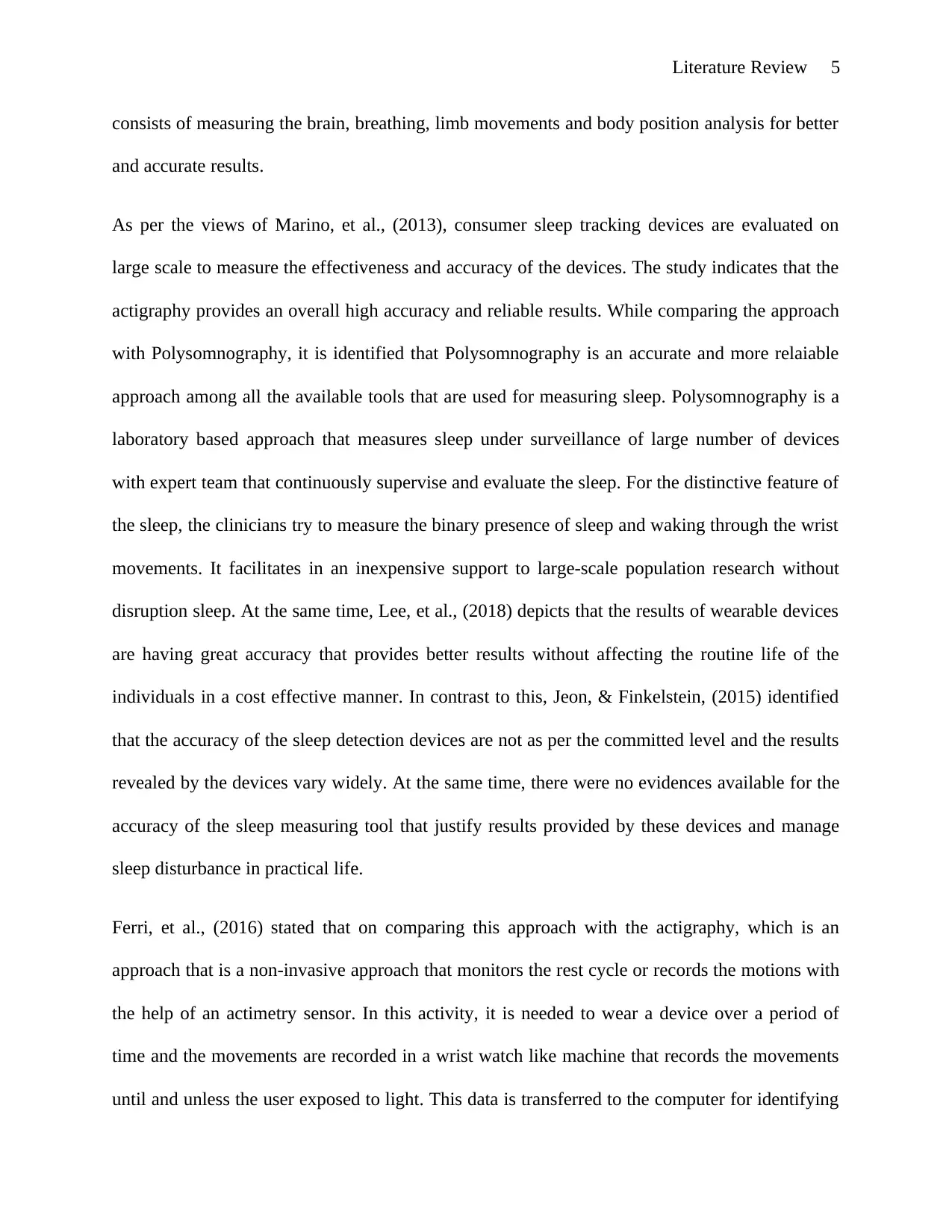
Literature Review 5
consists of measuring the brain, breathing, limb movements and body position analysis for better
and accurate results.
As per the views of Marino, et al., (2013), consumer sleep tracking devices are evaluated on
large scale to measure the effectiveness and accuracy of the devices. The study indicates that the
actigraphy provides an overall high accuracy and reliable results. While comparing the approach
with Polysomnography, it is identified that Polysomnography is an accurate and more relaiable
approach among all the available tools that are used for measuring sleep. Polysomnography is a
laboratory based approach that measures sleep under surveillance of large number of devices
with expert team that continuously supervise and evaluate the sleep. For the distinctive feature of
the sleep, the clinicians try to measure the binary presence of sleep and waking through the wrist
movements. It facilitates in an inexpensive support to large-scale population research without
disruption sleep. At the same time, Lee, et al., (2018) depicts that the results of wearable devices
are having great accuracy that provides better results without affecting the routine life of the
individuals in a cost effective manner. In contrast to this, Jeon, & Finkelstein, (2015) identified
that the accuracy of the sleep detection devices are not as per the committed level and the results
revealed by the devices vary widely. At the same time, there were no evidences available for the
accuracy of the sleep measuring tool that justify results provided by these devices and manage
sleep disturbance in practical life.
Ferri, et al., (2016) stated that on comparing this approach with the actigraphy, which is an
approach that is a non-invasive approach that monitors the rest cycle or records the motions with
the help of an actimetry sensor. In this activity, it is needed to wear a device over a period of
time and the movements are recorded in a wrist watch like machine that records the movements
until and unless the user exposed to light. This data is transferred to the computer for identifying
consists of measuring the brain, breathing, limb movements and body position analysis for better
and accurate results.
As per the views of Marino, et al., (2013), consumer sleep tracking devices are evaluated on
large scale to measure the effectiveness and accuracy of the devices. The study indicates that the
actigraphy provides an overall high accuracy and reliable results. While comparing the approach
with Polysomnography, it is identified that Polysomnography is an accurate and more relaiable
approach among all the available tools that are used for measuring sleep. Polysomnography is a
laboratory based approach that measures sleep under surveillance of large number of devices
with expert team that continuously supervise and evaluate the sleep. For the distinctive feature of
the sleep, the clinicians try to measure the binary presence of sleep and waking through the wrist
movements. It facilitates in an inexpensive support to large-scale population research without
disruption sleep. At the same time, Lee, et al., (2018) depicts that the results of wearable devices
are having great accuracy that provides better results without affecting the routine life of the
individuals in a cost effective manner. In contrast to this, Jeon, & Finkelstein, (2015) identified
that the accuracy of the sleep detection devices are not as per the committed level and the results
revealed by the devices vary widely. At the same time, there were no evidences available for the
accuracy of the sleep measuring tool that justify results provided by these devices and manage
sleep disturbance in practical life.
Ferri, et al., (2016) stated that on comparing this approach with the actigraphy, which is an
approach that is a non-invasive approach that monitors the rest cycle or records the motions with
the help of an actimetry sensor. In this activity, it is needed to wear a device over a period of
time and the movements are recorded in a wrist watch like machine that records the movements
until and unless the user exposed to light. This data is transferred to the computer for identifying

Literature Review 6
the sleep of the user. In some of the technology updated tools, this device provides real-time
updates and consolidated results of the period of analysis. It is also a concern that the actigraphy
might overestimate sleep and on the other side underestimate the wake time as the beginning of
sleep period are recorded in a special manner (Lee, et al., 2017). In actigraphy, the immobility of
the individual is considered as the beginning of the sleep period whereas PSG is more advanced
as it also considers the changes in the brain electrical activity patterns marked sets of sleep.
In the past few years, there are positive technological improvements in the actimetry sensor that
has resulted in improvement in results and accuracy of the device. In addition, the approach is
now considering the high memory storage, three-axis accelerometer sensors, high sampling rate.
There is also use of the heart rate, blood circulation and its atomized synchronization with the
Smartphones leads to improvement in the results of the device (Conrad, Karlik, Lewandowski
Holley, Wilson, & Koh, 2017). Also, the device is to be placed on the wrist of non-dominant
hand for measurement of sleep and sensitivity to normal and monitors heart rate automatically.
There are some of the shortcomings of PSG that include the need of the individual to spend time
in a lab and at the same time, pre-identified situation with the brain for the upcoming event
sometimes results to affect the sleep which may lead to influence the results. In addition to this,
expensiveness, time consumption for both the evaluators and individuals is a little impractical
approach to spend a long period of time in the laboratory. These are factors that affect the use of
the method. At the same time, lack of home recording and its limited availability has resulted in
new methods to objectively evaluation of sleep (Mantua, et al., 2016). Although, there are some
lacking areas associated with the PSG still it is a widely accepted and more accurate approach to
measure sleep.
the sleep of the user. In some of the technology updated tools, this device provides real-time
updates and consolidated results of the period of analysis. It is also a concern that the actigraphy
might overestimate sleep and on the other side underestimate the wake time as the beginning of
sleep period are recorded in a special manner (Lee, et al., 2017). In actigraphy, the immobility of
the individual is considered as the beginning of the sleep period whereas PSG is more advanced
as it also considers the changes in the brain electrical activity patterns marked sets of sleep.
In the past few years, there are positive technological improvements in the actimetry sensor that
has resulted in improvement in results and accuracy of the device. In addition, the approach is
now considering the high memory storage, three-axis accelerometer sensors, high sampling rate.
There is also use of the heart rate, blood circulation and its atomized synchronization with the
Smartphones leads to improvement in the results of the device (Conrad, Karlik, Lewandowski
Holley, Wilson, & Koh, 2017). Also, the device is to be placed on the wrist of non-dominant
hand for measurement of sleep and sensitivity to normal and monitors heart rate automatically.
There are some of the shortcomings of PSG that include the need of the individual to spend time
in a lab and at the same time, pre-identified situation with the brain for the upcoming event
sometimes results to affect the sleep which may lead to influence the results. In addition to this,
expensiveness, time consumption for both the evaluators and individuals is a little impractical
approach to spend a long period of time in the laboratory. These are factors that affect the use of
the method. At the same time, lack of home recording and its limited availability has resulted in
new methods to objectively evaluation of sleep (Mantua, et al., 2016). Although, there are some
lacking areas associated with the PSG still it is a widely accepted and more accurate approach to
measure sleep.
⊘ This is a preview!⊘
Do you want full access?
Subscribe today to unlock all pages.

Trusted by 1+ million students worldwide
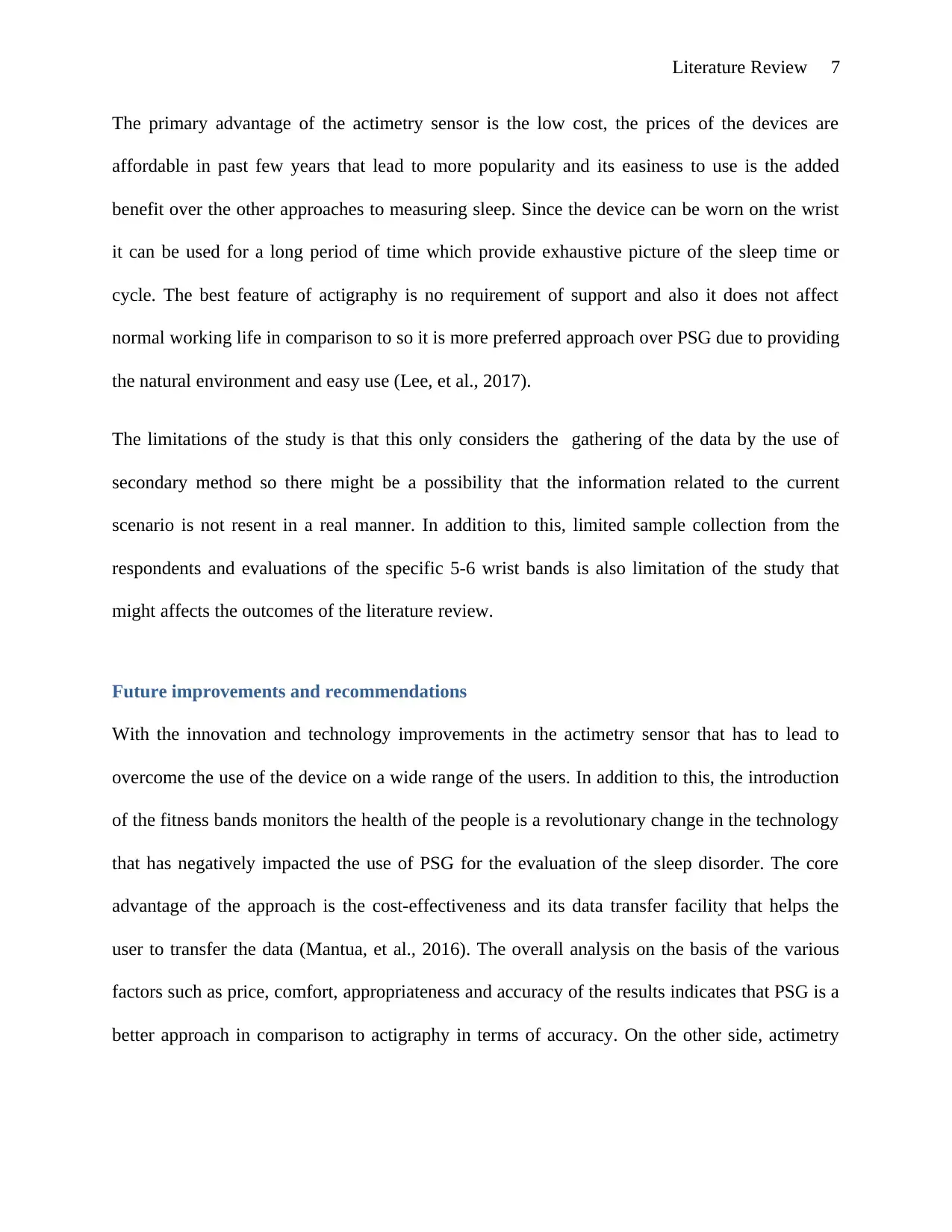
Literature Review 7
The primary advantage of the actimetry sensor is the low cost, the prices of the devices are
affordable in past few years that lead to more popularity and its easiness to use is the added
benefit over the other approaches to measuring sleep. Since the device can be worn on the wrist
it can be used for a long period of time which provide exhaustive picture of the sleep time or
cycle. The best feature of actigraphy is no requirement of support and also it does not affect
normal working life in comparison to so it is more preferred approach over PSG due to providing
the natural environment and easy use (Lee, et al., 2017).
The limitations of the study is that this only considers the gathering of the data by the use of
secondary method so there might be a possibility that the information related to the current
scenario is not resent in a real manner. In addition to this, limited sample collection from the
respondents and evaluations of the specific 5-6 wrist bands is also limitation of the study that
might affects the outcomes of the literature review.
Future improvements and recommendations
With the innovation and technology improvements in the actimetry sensor that has to lead to
overcome the use of the device on a wide range of the users. In addition to this, the introduction
of the fitness bands monitors the health of the people is a revolutionary change in the technology
that has negatively impacted the use of PSG for the evaluation of the sleep disorder. The core
advantage of the approach is the cost-effectiveness and its data transfer facility that helps the
user to transfer the data (Mantua, et al., 2016). The overall analysis on the basis of the various
factors such as price, comfort, appropriateness and accuracy of the results indicates that PSG is a
better approach in comparison to actigraphy in terms of accuracy. On the other side, actimetry
The primary advantage of the actimetry sensor is the low cost, the prices of the devices are
affordable in past few years that lead to more popularity and its easiness to use is the added
benefit over the other approaches to measuring sleep. Since the device can be worn on the wrist
it can be used for a long period of time which provide exhaustive picture of the sleep time or
cycle. The best feature of actigraphy is no requirement of support and also it does not affect
normal working life in comparison to so it is more preferred approach over PSG due to providing
the natural environment and easy use (Lee, et al., 2017).
The limitations of the study is that this only considers the gathering of the data by the use of
secondary method so there might be a possibility that the information related to the current
scenario is not resent in a real manner. In addition to this, limited sample collection from the
respondents and evaluations of the specific 5-6 wrist bands is also limitation of the study that
might affects the outcomes of the literature review.
Future improvements and recommendations
With the innovation and technology improvements in the actimetry sensor that has to lead to
overcome the use of the device on a wide range of the users. In addition to this, the introduction
of the fitness bands monitors the health of the people is a revolutionary change in the technology
that has negatively impacted the use of PSG for the evaluation of the sleep disorder. The core
advantage of the approach is the cost-effectiveness and its data transfer facility that helps the
user to transfer the data (Mantua, et al., 2016). The overall analysis on the basis of the various
factors such as price, comfort, appropriateness and accuracy of the results indicates that PSG is a
better approach in comparison to actigraphy in terms of accuracy. On the other side, actimetry
Paraphrase This Document
Need a fresh take? Get an instant paraphrase of this document with our AI Paraphraser
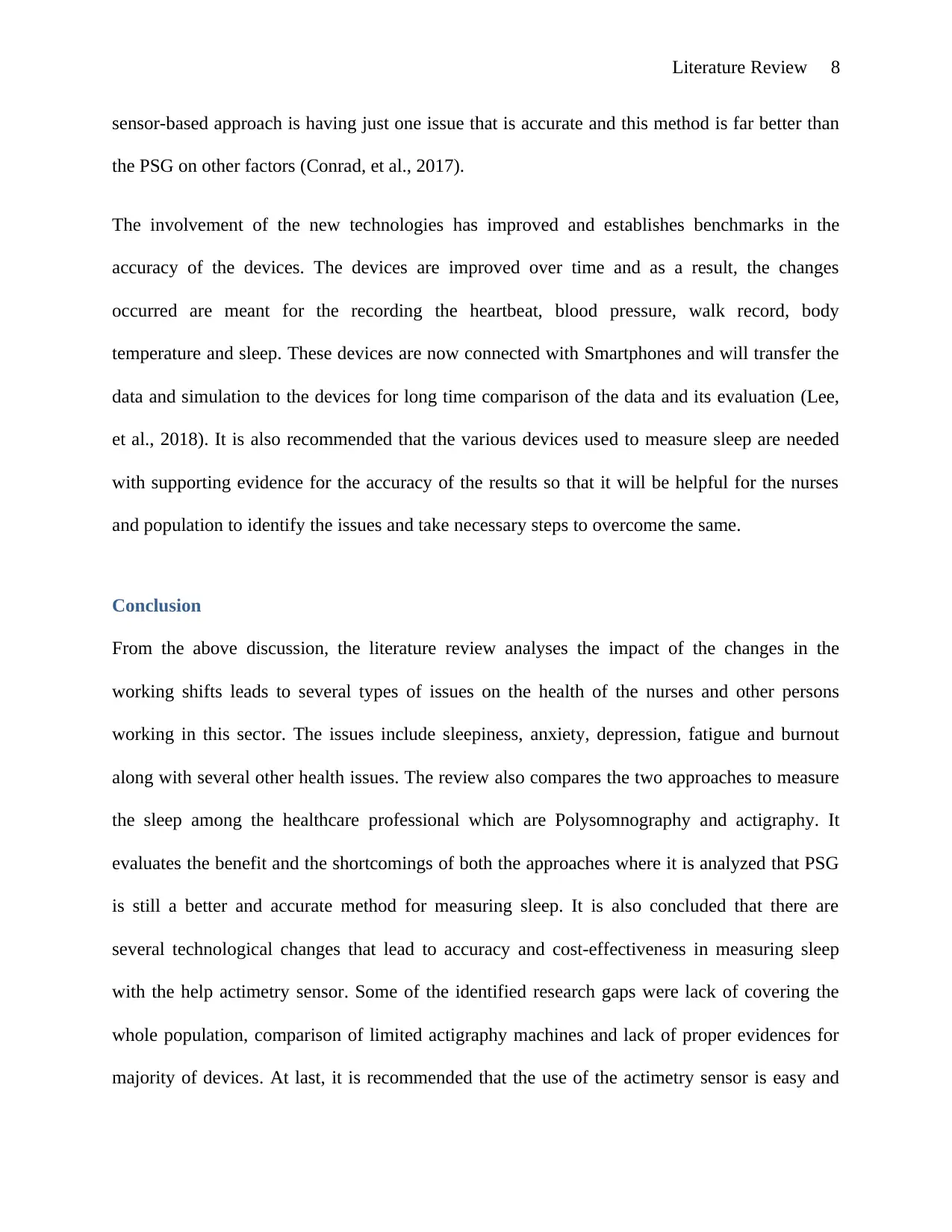
Literature Review 8
sensor-based approach is having just one issue that is accurate and this method is far better than
the PSG on other factors (Conrad, et al., 2017).
The involvement of the new technologies has improved and establishes benchmarks in the
accuracy of the devices. The devices are improved over time and as a result, the changes
occurred are meant for the recording the heartbeat, blood pressure, walk record, body
temperature and sleep. These devices are now connected with Smartphones and will transfer the
data and simulation to the devices for long time comparison of the data and its evaluation (Lee,
et al., 2018). It is also recommended that the various devices used to measure sleep are needed
with supporting evidence for the accuracy of the results so that it will be helpful for the nurses
and population to identify the issues and take necessary steps to overcome the same.
Conclusion
From the above discussion, the literature review analyses the impact of the changes in the
working shifts leads to several types of issues on the health of the nurses and other persons
working in this sector. The issues include sleepiness, anxiety, depression, fatigue and burnout
along with several other health issues. The review also compares the two approaches to measure
the sleep among the healthcare professional which are Polysomnography and actigraphy. It
evaluates the benefit and the shortcomings of both the approaches where it is analyzed that PSG
is still a better and accurate method for measuring sleep. It is also concluded that there are
several technological changes that lead to accuracy and cost-effectiveness in measuring sleep
with the help actimetry sensor. Some of the identified research gaps were lack of covering the
whole population, comparison of limited actigraphy machines and lack of proper evidences for
majority of devices. At last, it is recommended that the use of the actimetry sensor is easy and
sensor-based approach is having just one issue that is accurate and this method is far better than
the PSG on other factors (Conrad, et al., 2017).
The involvement of the new technologies has improved and establishes benchmarks in the
accuracy of the devices. The devices are improved over time and as a result, the changes
occurred are meant for the recording the heartbeat, blood pressure, walk record, body
temperature and sleep. These devices are now connected with Smartphones and will transfer the
data and simulation to the devices for long time comparison of the data and its evaluation (Lee,
et al., 2018). It is also recommended that the various devices used to measure sleep are needed
with supporting evidence for the accuracy of the results so that it will be helpful for the nurses
and population to identify the issues and take necessary steps to overcome the same.
Conclusion
From the above discussion, the literature review analyses the impact of the changes in the
working shifts leads to several types of issues on the health of the nurses and other persons
working in this sector. The issues include sleepiness, anxiety, depression, fatigue and burnout
along with several other health issues. The review also compares the two approaches to measure
the sleep among the healthcare professional which are Polysomnography and actigraphy. It
evaluates the benefit and the shortcomings of both the approaches where it is analyzed that PSG
is still a better and accurate method for measuring sleep. It is also concluded that there are
several technological changes that lead to accuracy and cost-effectiveness in measuring sleep
with the help actimetry sensor. Some of the identified research gaps were lack of covering the
whole population, comparison of limited actigraphy machines and lack of proper evidences for
majority of devices. At last, it is recommended that the use of the actimetry sensor is easy and
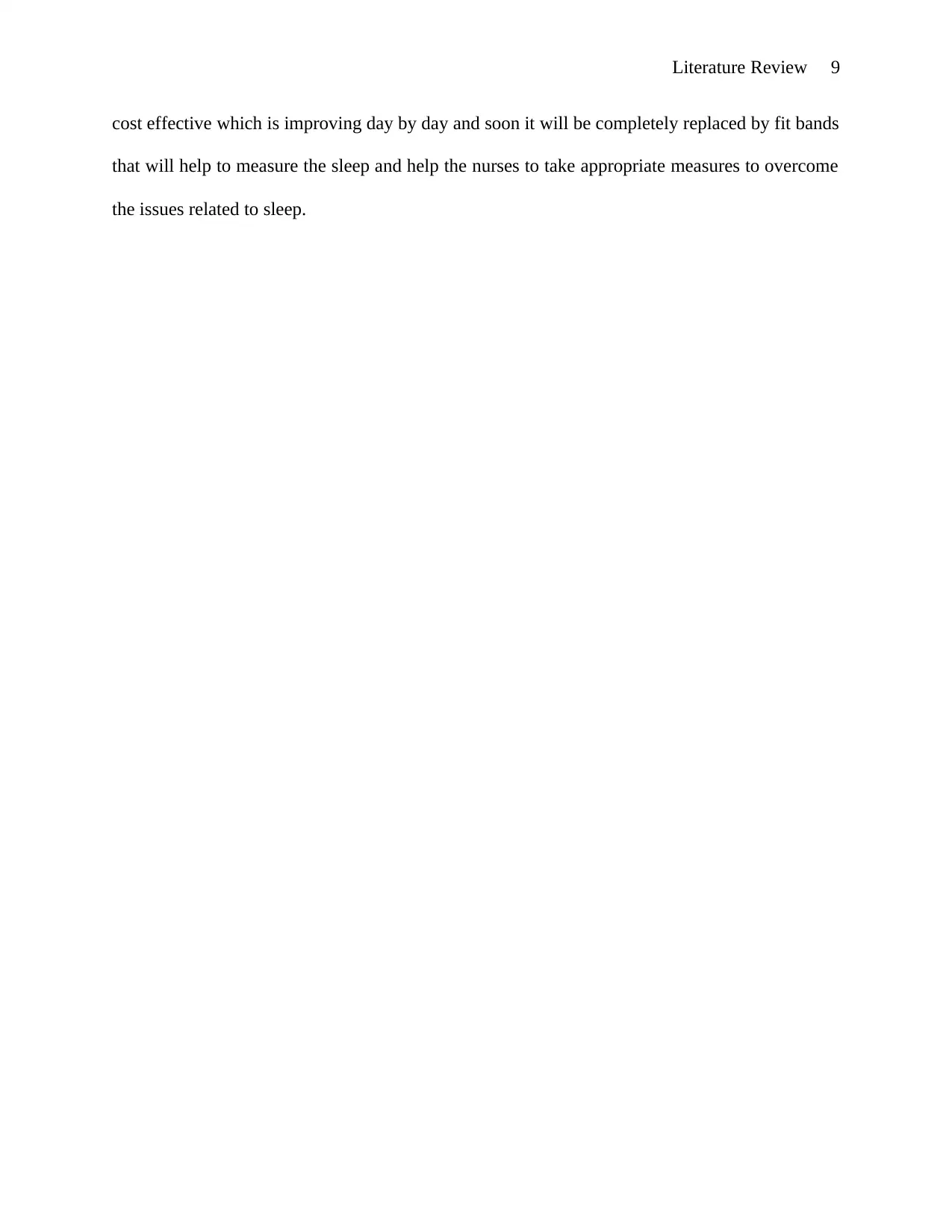
Literature Review 9
cost effective which is improving day by day and soon it will be completely replaced by fit bands
that will help to measure the sleep and help the nurses to take appropriate measures to overcome
the issues related to sleep.
cost effective which is improving day by day and soon it will be completely replaced by fit bands
that will help to measure the sleep and help the nurses to take appropriate measures to overcome
the issues related to sleep.
⊘ This is a preview!⊘
Do you want full access?
Subscribe today to unlock all pages.

Trusted by 1+ million students worldwide
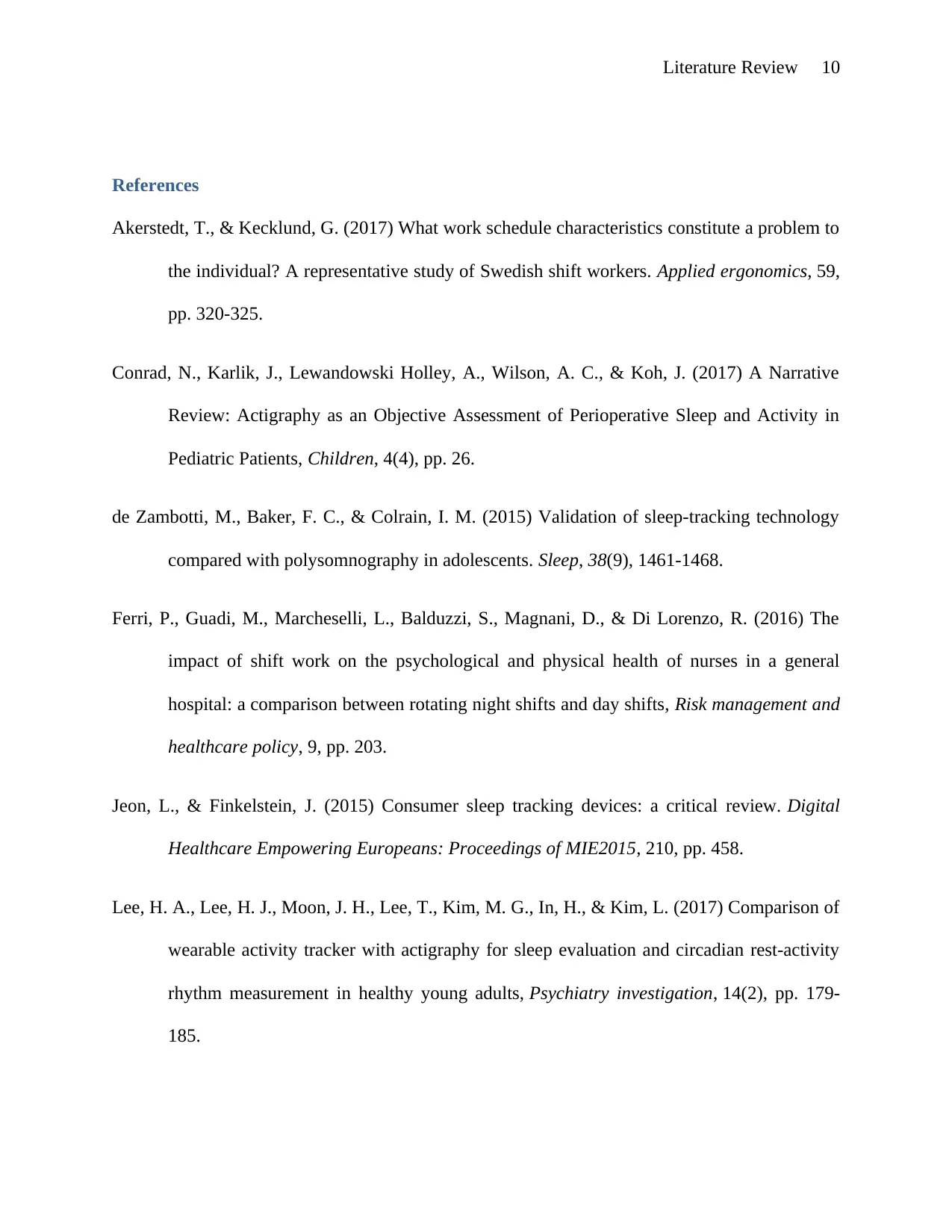
Literature Review 10
References
Akerstedt, T., & Kecklund, G. (2017) What work schedule characteristics constitute a problem to
the individual? A representative study of Swedish shift workers. Applied ergonomics, 59,
pp. 320-325.
Conrad, N., Karlik, J., Lewandowski Holley, A., Wilson, A. C., & Koh, J. (2017) A Narrative
Review: Actigraphy as an Objective Assessment of Perioperative Sleep and Activity in
Pediatric Patients, Children, 4(4), pp. 26.
de Zambotti, M., Baker, F. C., & Colrain, I. M. (2015) Validation of sleep-tracking technology
compared with polysomnography in adolescents. Sleep, 38(9), 1461-1468.
Ferri, P., Guadi, M., Marcheselli, L., Balduzzi, S., Magnani, D., & Di Lorenzo, R. (2016) The
impact of shift work on the psychological and physical health of nurses in a general
hospital: a comparison between rotating night shifts and day shifts, Risk management and
healthcare policy, 9, pp. 203.
Jeon, L., & Finkelstein, J. (2015) Consumer sleep tracking devices: a critical review. Digital
Healthcare Empowering Europeans: Proceedings of MIE2015, 210, pp. 458.
Lee, H. A., Lee, H. J., Moon, J. H., Lee, T., Kim, M. G., In, H., & Kim, L. (2017) Comparison of
wearable activity tracker with actigraphy for sleep evaluation and circadian rest-activity
rhythm measurement in healthy young adults, Psychiatry investigation, 14(2), pp. 179-
185.
References
Akerstedt, T., & Kecklund, G. (2017) What work schedule characteristics constitute a problem to
the individual? A representative study of Swedish shift workers. Applied ergonomics, 59,
pp. 320-325.
Conrad, N., Karlik, J., Lewandowski Holley, A., Wilson, A. C., & Koh, J. (2017) A Narrative
Review: Actigraphy as an Objective Assessment of Perioperative Sleep and Activity in
Pediatric Patients, Children, 4(4), pp. 26.
de Zambotti, M., Baker, F. C., & Colrain, I. M. (2015) Validation of sleep-tracking technology
compared with polysomnography in adolescents. Sleep, 38(9), 1461-1468.
Ferri, P., Guadi, M., Marcheselli, L., Balduzzi, S., Magnani, D., & Di Lorenzo, R. (2016) The
impact of shift work on the psychological and physical health of nurses in a general
hospital: a comparison between rotating night shifts and day shifts, Risk management and
healthcare policy, 9, pp. 203.
Jeon, L., & Finkelstein, J. (2015) Consumer sleep tracking devices: a critical review. Digital
Healthcare Empowering Europeans: Proceedings of MIE2015, 210, pp. 458.
Lee, H. A., Lee, H. J., Moon, J. H., Lee, T., Kim, M. G., In, H., & Kim, L. (2017) Comparison of
wearable activity tracker with actigraphy for sleep evaluation and circadian rest-activity
rhythm measurement in healthy young adults, Psychiatry investigation, 14(2), pp. 179-
185.
Paraphrase This Document
Need a fresh take? Get an instant paraphrase of this document with our AI Paraphraser

Literature Review 11
Lee, J. M., Byun, W., Keill, A., Dinkel, D., & Seo, Y. (2018) Comparison of Wearable Trackers’
Ability to Estimate Sleep, International journal of environmental research and public
health, 15(6), pp. 1265.
Mantua, J., Gravel, N., & Spencer, R. (2016) Reliability of sleep measures from four personal
health monitoring devices compared to research-based actigraphy and
polysomnography, Sensors, 16(5), pp. 646.
Marino, M., Li, Y., Rueschman, M. N., Winkelman, J. W., Ellenbogen, J. M., Solet, J. M., ... &
Buxton, O. M. (2013) Measuring sleep: accuracy, sensitivity, and specificity of wrist
actigraphy compared to polysomnography, Sleep, 36(11), pp. 1747-1755.
Ogeil, R. P., Barger, L. K., Lockley, S. W., O’Brien, C. S., Sullivan, J. P., Qadri, S., &
Rajaratnam, S. M. (2018) Cross-sectional analysis of sleep-promoting and wake-
promoting drug use on health, fatigue-related error, and near-crashes in police
officers, BMJ open, 8(9), e022041.
Lee, J. M., Byun, W., Keill, A., Dinkel, D., & Seo, Y. (2018) Comparison of Wearable Trackers’
Ability to Estimate Sleep, International journal of environmental research and public
health, 15(6), pp. 1265.
Mantua, J., Gravel, N., & Spencer, R. (2016) Reliability of sleep measures from four personal
health monitoring devices compared to research-based actigraphy and
polysomnography, Sensors, 16(5), pp. 646.
Marino, M., Li, Y., Rueschman, M. N., Winkelman, J. W., Ellenbogen, J. M., Solet, J. M., ... &
Buxton, O. M. (2013) Measuring sleep: accuracy, sensitivity, and specificity of wrist
actigraphy compared to polysomnography, Sleep, 36(11), pp. 1747-1755.
Ogeil, R. P., Barger, L. K., Lockley, S. W., O’Brien, C. S., Sullivan, J. P., Qadri, S., &
Rajaratnam, S. M. (2018) Cross-sectional analysis of sleep-promoting and wake-
promoting drug use on health, fatigue-related error, and near-crashes in police
officers, BMJ open, 8(9), e022041.
1 out of 11
Related Documents
Your All-in-One AI-Powered Toolkit for Academic Success.
+13062052269
info@desklib.com
Available 24*7 on WhatsApp / Email
![[object Object]](/_next/static/media/star-bottom.7253800d.svg)
Unlock your academic potential
Copyright © 2020–2025 A2Z Services. All Rights Reserved. Developed and managed by ZUCOL.





